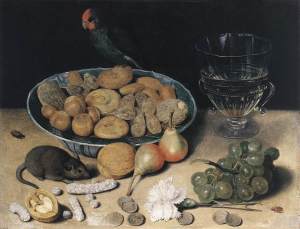 From the looks of the mouse, he couldn’t be more fortunate sitting among the confectionery; after all, the small creature, like many of us, is known to have a bit of a sweet tooth. We’ve seen what happens “if you give a mouse a cookie.” But here on the tabletop in the early 1600s, instead of chocolate chips, he’s tempted by “ragged” comfits—short ribbons of cinnamon with some twenty coats of a sugar syrup that makes them look like those Styrofoam packing peanuts—and sugarplums, round and oval, often made of dried figs and almonds, flavored with anise and cardamom, in a labor-intensive process to develop their hard candy shells.[1] Before this mouse, however, begins to enjoy himself with an espresso to wash it all down, there’s something that might give him pause if he understood his hapless role in seventeenth-century people’s spiritual outlook.
From the looks of the mouse, he couldn’t be more fortunate sitting among the confectionery; after all, the small creature, like many of us, is known to have a bit of a sweet tooth. We’ve seen what happens “if you give a mouse a cookie.” But here on the tabletop in the early 1600s, instead of chocolate chips, he’s tempted by “ragged” comfits—short ribbons of cinnamon with some twenty coats of a sugar syrup that makes them look like those Styrofoam packing peanuts—and sugarplums, round and oval, often made of dried figs and almonds, flavored with anise and cardamom, in a labor-intensive process to develop their hard candy shells.[1] Before this mouse, however, begins to enjoy himself with an espresso to wash it all down, there’s something that might give him pause if he understood his hapless role in seventeenth-century people’s spiritual outlook.
The painter, Georg Flegel, who is considered to be “the most important representative of early German still lifes,” used sugar in place of honey as the symbol of “spiritual sweetness” and, to my mind, went a bit crazy.[2] His Dessert Still Life painting must be one of the most overarching displays of religious symbolism ever, in which the open walnut, we’re told, according to St. Augustine, is a symbol of Christ, the shell suggesting the “wooden cross” and the nutmeat, Christ’s “divinity.”[3] Flegel then added a wine glass and a bunch of grapes to underscore the Eucharist; a white carnation as an emblem from the Middle Ages for Christ on the cross, the flower’s petals resembling the nails; and coins to remind us of Judas’s “betrayal of Jesus for thirty pieces of silver.” The painter also tossed into a bowl additional nuts and figs, dusted with sugar, to represent a wealth of religious principles. Not quite done, he introduced into the painting its two most arresting subjects: a green parrot and a gray mouse. Their own symbolism Flegel makes clear: Look who’s been assigned to stand guard over the bowl-full of “spiritual values” and look who’s snuck in to gnaw on the “cross.” The mouse has been freighted with sin. Once again.
Nevertheless, the superabundance of theological allusions might just be ‘icing on the cake.’ Dessert Still Life points to Europeans’ passion at the time for sugar—a luxury item which they had recently imported from Brazil—as well as their appreciation for Flegel’s artistry. In today’s context, his depiction of the mouse appears not at all evil but innocent—and surely with visions of sugarplums dancing in his head.
.
[2] Norbert Schneider, Still Life, Taschen, 1990, trans. by Hugh Beyer.
[3] For a complete discussion of religious symbolism in Flegel’s paintings, see Schneider, ibid.
(Image: Dessert Still Life, oil on board, early 17th century, 22 x 28 cm)
Leave a comment